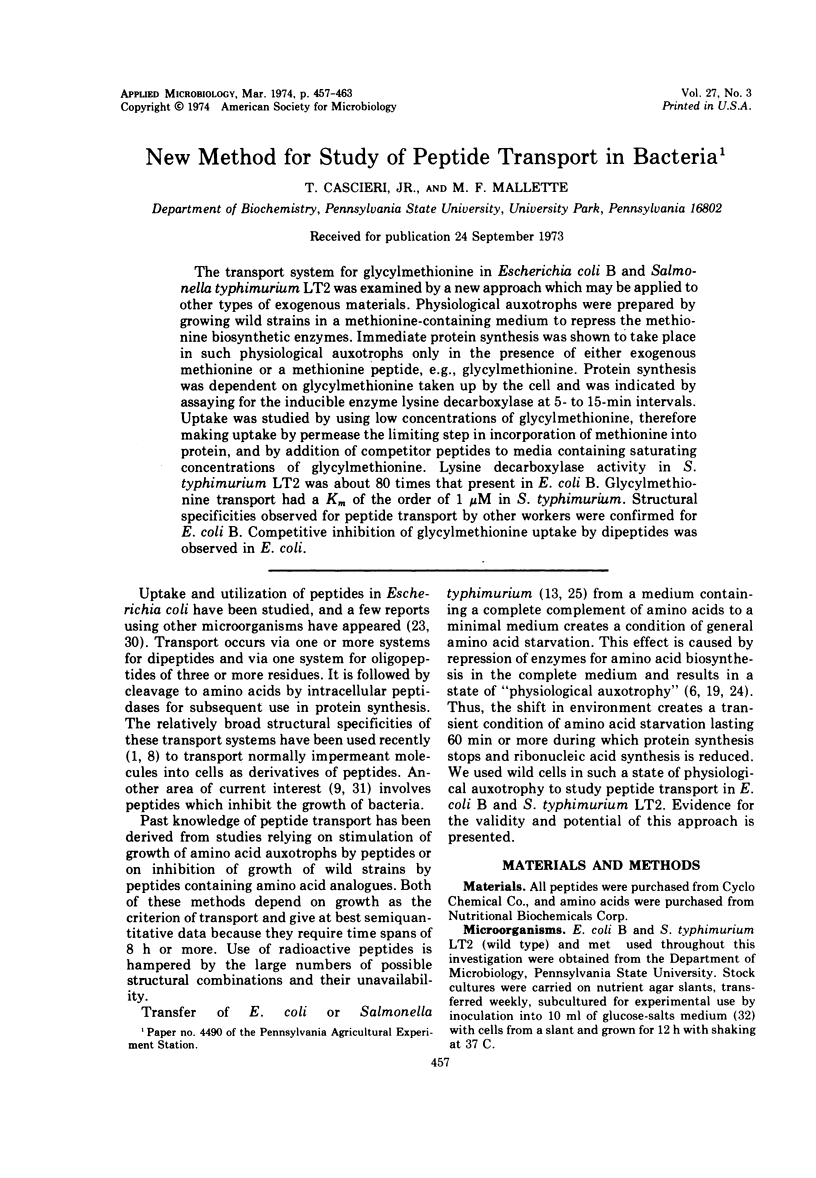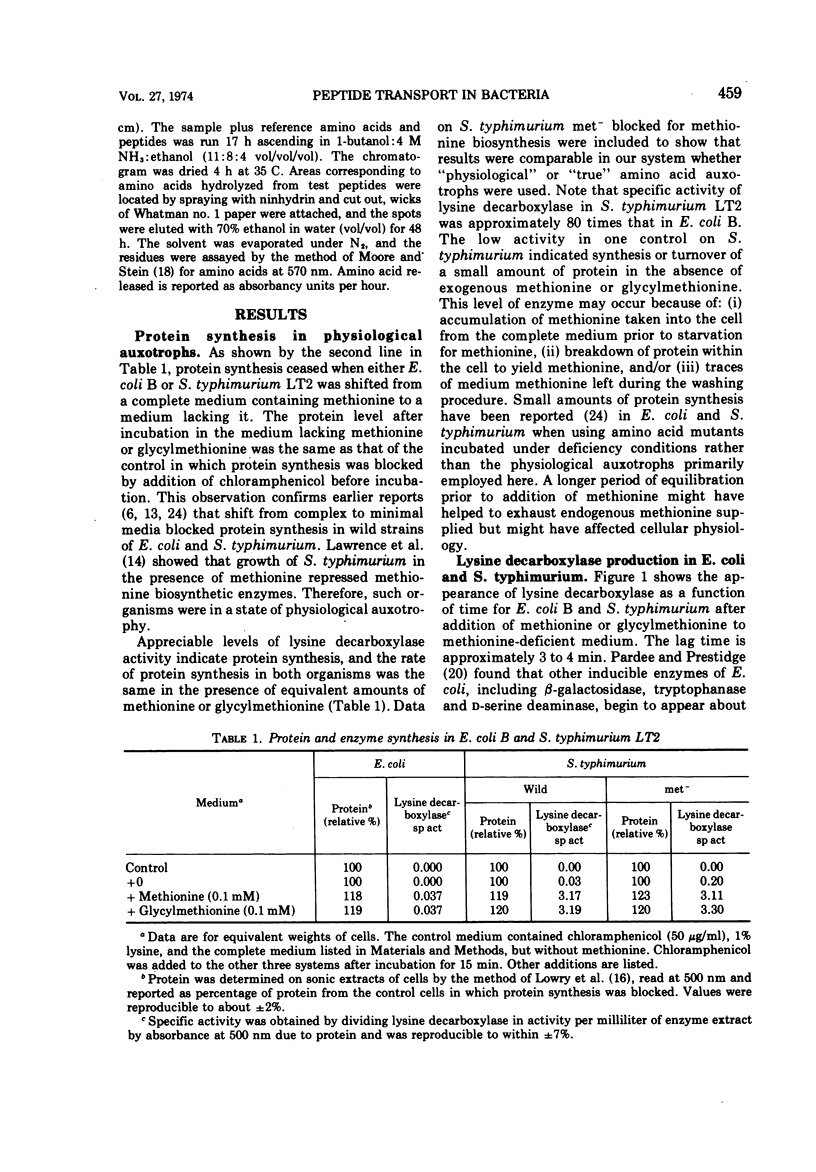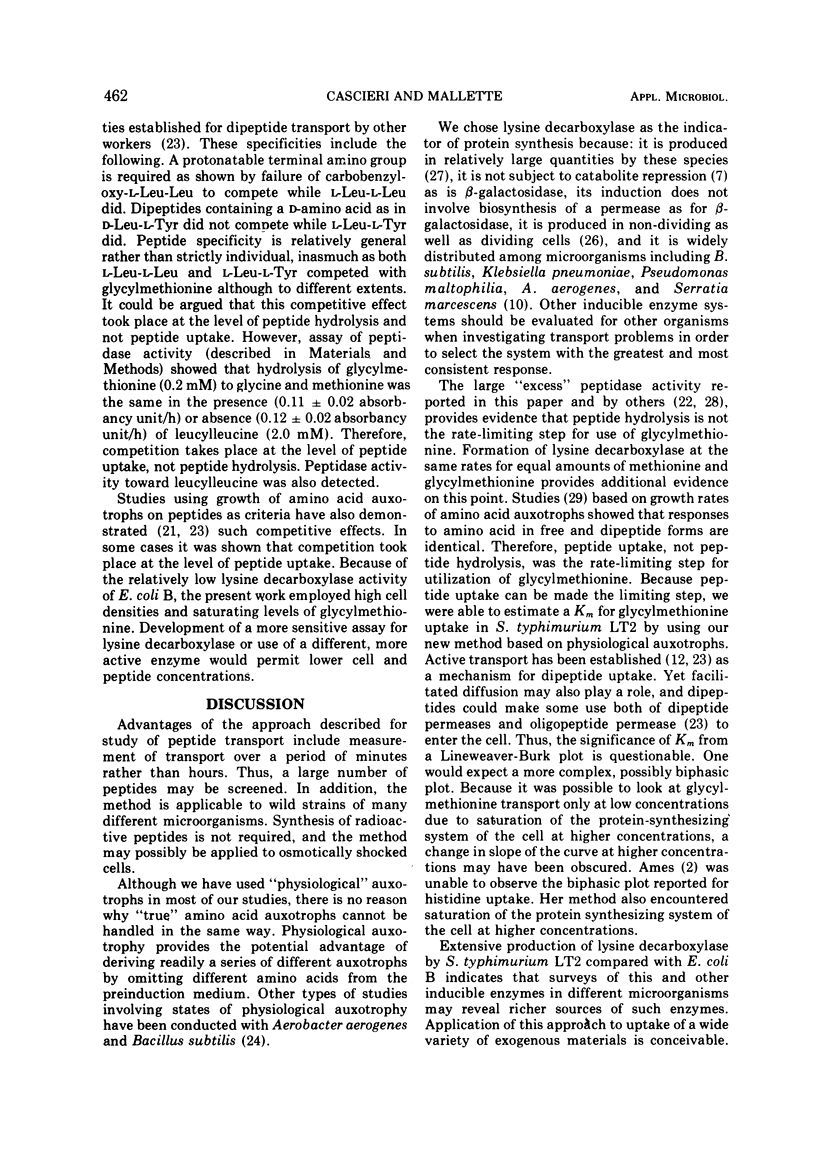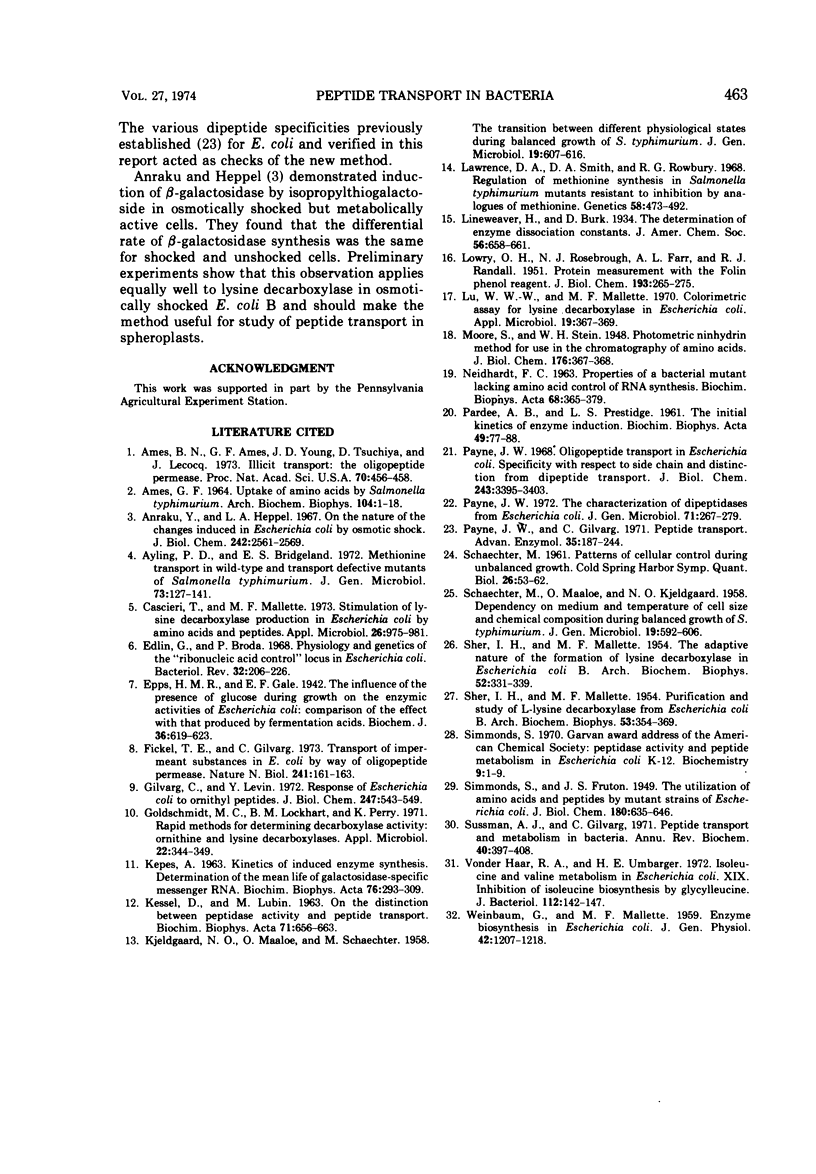Abstract
The transport system for glycylmethionine in Escherichia coli B and Salmonella typhimurium LT2 was examined by a new approach which may be applied to other types of exogenous materials. Physiological auxotrophs were prepared by growing wild strains in a methionine-containing medium to repress the methionine biosynthetic enzymes. Immediate protein synthesis was shown to take place in such physiological auxotrophs only in the presence of either exogenous methionine or a methionine peptide, e.g., glycylmethionine. Protein synthesis was dependent on glycylmethionine taken up by the cell and was indicated by assaying for the inducible enzyme lysine decarboxylase at 5- to 15-min intervals. Uptake was studied by using low concentrations of glycylmethionine, therefore making uptake by permease the limiting step in incorporation of methionine into protein, and by addition of competitor peptides to media containing saturating concentrations of glycylmethionine. Lysine decarboxylase activity in S. typhimurium LT2 was about 80 times that present in E. coli B. Glycylmethionine transport had a Km of the order of 1 μM in S. typhimurium. Structural specificities observed for peptide transport by other workers were confirmed for E. coli B. Competitive inhibition of glycylmethionine uptake by dipeptides was observed in E. coli.
Full text
PDF






Selected References
These references are in PubMed. This may not be the complete list of references from this article.
- AMES G. F. UPTAKE OF AMINO ACIDS BY SALMONELLA TYPHIMURIUM. Arch Biochem Biophys. 1964 Jan;104:1–18. doi: 10.1016/s0003-9861(64)80028-x. [DOI] [PubMed] [Google Scholar]
- Ames B. N., Ames G. F., Young J. D., Tsuchiya D., Lecocq J. Illicit transport: the oligopeptide permease. Proc Natl Acad Sci U S A. 1973 Feb;70(2):456–458. doi: 10.1073/pnas.70.2.456. [DOI] [PMC free article] [PubMed] [Google Scholar]
- Anraku Y., Heppel L. A. On the nature of the changes induced in Escherichia coli by osmotic shock. J Biol Chem. 1967 May 25;242(10):2561–2569. [PubMed] [Google Scholar]
- Ayling P. D., Bridgeland E. S. Methionine transport in wild-type and transport-defective mutants of Salmonella typhimurium. J Gen Microbiol. 1972 Nov;73(1):127–141. doi: 10.1099/00221287-73-1-127. [DOI] [PubMed] [Google Scholar]
- Cascieri T., Jr, Mallette M. F. Stimulation of lysine decarboxylase production in Escherichia coli by amino acids and peptides. Appl Microbiol. 1973 Dec;26(6):975–981. doi: 10.1128/am.26.6.975-981.1973. [DOI] [PMC free article] [PubMed] [Google Scholar]
- Edlin G., Broda P. Physiology and genetics of the "ribonucleic acid control" locus in escherichia coli. Bacteriol Rev. 1968 Sep;32(3):206–226. doi: 10.1128/br.32.3.206-226.1968. [DOI] [PMC free article] [PubMed] [Google Scholar]
- Epps H. M., Gale E. F. The influence of the presence of glucose during growth on the enzymic activities of Escherichia coli: comparison of the effect with that produced by fermentation acids. Biochem J. 1942 Sep;36(7-9):619–623. doi: 10.1042/bj0360619. [DOI] [PMC free article] [PubMed] [Google Scholar]
- Fickel T. E., Gilvarg C. Transport of impermeant substances in E. coli by way of oligopeptide permease. Nat New Biol. 1973 Feb 7;241(110):161–163. doi: 10.1038/newbio241161a0. [DOI] [PubMed] [Google Scholar]
- Gilvarg C., Levin Y. Response of Escherichia coli to ornithyl peptides. J Biol Chem. 1972 Jan 25;247(2):543–549. [PubMed] [Google Scholar]
- Goldschmidt M. C., Lockhart B. M., Perry K. Rapid methods for determining decarboxylase activity: ornithine and lysine decarboxylases. Appl Microbiol. 1971 Sep;22(3):344–349. doi: 10.1128/am.22.3.344-349.1971. [DOI] [PMC free article] [PubMed] [Google Scholar]
- KEPES A. KINETICS OF INDUCED ENZYME SYNTHESIS. DETERMINATION OF THE MEAN LIFE OF GALACTOSIDASE-SPECIFIC MESSENGER RNA. Biochim Biophys Acta. 1963 Oct 15;76:293–309. [PubMed] [Google Scholar]
- KESSEL D., LUBIN M. On the distinction between peptidase activity and peptide transport. Biochim Biophys Acta. 1963 Jun 4;71:656–663. doi: 10.1016/0006-3002(63)91139-9. [DOI] [PubMed] [Google Scholar]
- KJELDGAARD N. O., MAALOE O., SCHAECHTER M. The transition between different physiological states during balanced growth of Salmonella typhimurium. J Gen Microbiol. 1958 Dec;19(3):607–616. doi: 10.1099/00221287-19-3-607. [DOI] [PubMed] [Google Scholar]
- LOWRY O. H., ROSEBROUGH N. J., FARR A. L., RANDALL R. J. Protein measurement with the Folin phenol reagent. J Biol Chem. 1951 Nov;193(1):265–275. [PubMed] [Google Scholar]
- Lawrence D. A., Smith D. A., Rowbury R. J. Regulation of methionine synthesis in Salmonella typhimurium: mutants resistant to inhibition by analogues of methionine. Genetics. 1968 Apr;58(4):473–492. doi: 10.1093/genetics/58.4.473. [DOI] [PMC free article] [PubMed] [Google Scholar]
- Lu W. W., Mallette M. F. Colorimetric assay for lysine decarboxylase in Escherichia coli. Appl Microbiol. 1970 Feb;19(2):367–369. doi: 10.1128/am.19.2.367-369.1970. [DOI] [PMC free article] [PubMed] [Google Scholar]
- NEIDHARDT F. C. Properties of a bacterial mutant lacking amino acid control of RNA synthesis. Biochim Biophys Acta. 1963 Mar 26;68:365–379. doi: 10.1016/0006-3002(63)90158-6. [DOI] [PubMed] [Google Scholar]
- PARDEE A. B., PRESTIDGE L. S. The initial kinetics of enzyme induction. Biochim Biophys Acta. 1961 Apr 29;49:77–88. doi: 10.1016/0006-3002(61)90871-x. [DOI] [PubMed] [Google Scholar]
- Payne J. W. Oligopeptide transport in Escherichia coli. Specificity with respect to side chain and distinction from dipeptide transport. J Biol Chem. 1968 Jun 25;243(12):3395–3403. [PubMed] [Google Scholar]
- Payne J. W. The characterization of dipeptidases from Escherichia coli. J Gen Microbiol. 1972 Jul;71(2):267–279. doi: 10.1099/00221287-71-2-267. [DOI] [PubMed] [Google Scholar]
- SCHAECHTER M., MAALOE O., KJELDGAARD N. O. Dependency on medium and temperature of cell size and chemical composition during balanced grown of Salmonella typhimurium. J Gen Microbiol. 1958 Dec;19(3):592–606. doi: 10.1099/00221287-19-3-592. [DOI] [PubMed] [Google Scholar]
- SCHAECHTER M. Patterns of cellular control during unbalanced growth. Cold Spring Harb Symp Quant Biol. 1961;26:53–62. doi: 10.1101/sqb.1961.026.01.011. [DOI] [PubMed] [Google Scholar]
- SHER I. H., MALLETTE M. F. Purification and study of L-lysine decarboxylase from Escherichia coli B. Arch Biochem Biophys. 1954 Dec;53(2):354–369. doi: 10.1016/0003-9861(54)90417-8. [DOI] [PubMed] [Google Scholar]
- SHER I. H., MALLETTE M. F. The adaptive nature of the formation of lysine decarboxylase in Escherichia coli B. Arch Biochem Biophys. 1954 Oct;52(2):331–339. doi: 10.1016/0003-9861(54)90131-9. [DOI] [PubMed] [Google Scholar]
- Simmonds S. Garvan Award address of the American Chemical Society: peptidase activity and peptide metabolism in Escherichia coli K-12. Biochemistry. 1970 Jan 6;9(1):1–9. doi: 10.1021/bi00803a001. [DOI] [PubMed] [Google Scholar]
- Sussman A. J., Gilvarg C. Peptide transport and metabolism in bacteria. Annu Rev Biochem. 1971;40:397–408. doi: 10.1146/annurev.bi.40.070171.002145. [DOI] [PubMed] [Google Scholar]
- Vonder Haar R. A., Umbarger H. E. Isoleucine and valine metabolism in Escherichia coli. XIX. Inhibition of isoleucine biosynthesis by glycyl-leucine. J Bacteriol. 1972 Oct;112(1):142–147. doi: 10.1128/jb.112.1.142-147.1972. [DOI] [PMC free article] [PubMed] [Google Scholar]
- WEINBAUM G., MALLETTE M. F. Enzyme biosynthesis in Escherichia coli. J Gen Physiol. 1959 Jul 20;42(6):1207–1218. doi: 10.1085/jgp.42.6.1207. [DOI] [PMC free article] [PubMed] [Google Scholar]


